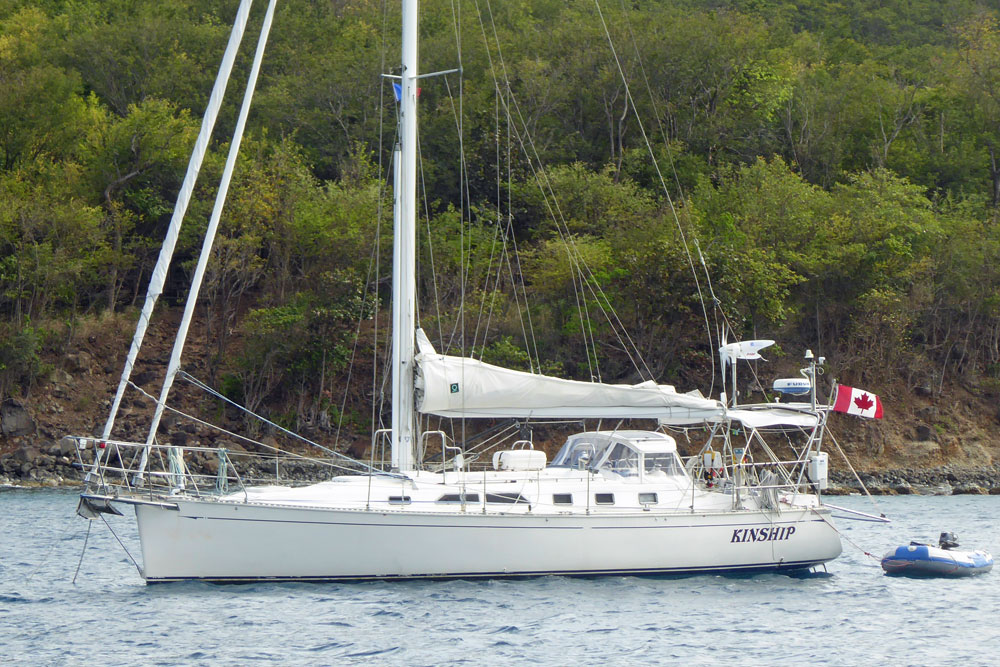- Home
- Cruising Yachts 40' to 45'
- Saga 43
The Saga 43 Sailboat
Specs & Key Performance Indicators
The Saga 43, a double-headed masthead sloop, was designed by Robert Perry and built in Canada by Saga Yachts.
Published Specification for the Saga 43
Underwater Profile: Bulb fin keel and spade rudder
Hull Material: GRP
Length Overall: 43'3" (13.2m)
Waterline Length: 38'11" (11.9m)
Beam: 12'0" (3.7m)
Draft: 6'3" (1.9m)
Rig Type: Masthead sloop
Displacement: 19,842lb (9,000kg)
Designer: Robert Perry
Builder: Saga Yachts (Canada)
Year First Built: 1996
Number Built: 55
Published Design Ratios for the Saga 43
Sail Area/Displacement Ratio: 20.9
Ballast/Displacement Ratio: 39.3
Displacement/Length Ratio: 150
Comfort Ratio: 27.9
Capsize Screening Formula: 1.8
Summary Analysis of the Design Ratios for the Saga 43
1. A Sail Area/Displacement Ratio of 20.9 suggests that, in the right hands, the Saga 43 will have enough performance to leave most other sailboats of similar waterline length well astern.
2. A Ballast/Displacement Ratio of 39.3 would usually mean that the Saga 43 would have a tendency to heel excessively in a gust, and need to be reefed early to keep her sailing upright in a moderate breeze.
However, as she carries much of her ballast concentrated in a bulb at the foot of the keel, she's likely to be considerably stiffer than her published Ballast/Displacement Ratio might suggest.
3. A Displacement/Length Ratio of 150, tells us the Saga 43 is clearly a light displacement sailboat. If she's loaded with too much heavy cruising gear her performance will suffer to a degree.
4. Ted Brewer's Comfort Ratio of 27.9 suggests that crew comfort of a Saga 43 in a seaway is similar to what you would associate with the motion of a coastal cruiser with moderate stability, which is not encouraging news for anyone prone to seasickness.
5. The Capsize Screening Formula (CSF) of 1.8 tells us that a Saga 43 would be a safer choice of sailboat for an ocean passage than one with a CSF of more than 2.0.
Saga 43 Sailboat: A Fast and Efficient Cruiser
If you are looking for a performance cruiser that can handle bluewater sailing, you might want to check out the Saga 43 sailing boat. This is a boat that was designed by Robert Perry, one of the most respected naval architects in the industry, with a specific purpose: to combine speed, comfort and function in a sleek package. The Saga 43 yacht has a lot of features that make it stand out from other cruisers in its class. Here are some of the main aspects of this boat:
Overview
The Saga 43 is a 43-foot masthead sloop that was first launched in 1996 by Saga Marine, a Canadian company founded by Allan Poole, a former manager of CS Yachts and Tartan Yachts. The boat was designed to appeal to owners who value performance and efficiency, as well as spaciousness and quality. The boat has a fine entry, with beam carried well forward, giving it a long waterline that increases speed and interior volume. The boat also has a low-profile cabin trunk, a large cockpit, and a wide transom with an integrated swim platform. The boat is steered by a single wheel mounted on a pedestal.
The Saga 43 is powered by a Yanmar diesel engine that delivers 56 hp. The engine is located under the companionway stairs and can be accessed from three sides. The boat has a fuel capacity of 60 gallons and a water capacity of 100 gallons. The boat also has two holding tanks, one for each head.
Accommodation
The Saga 43 has a spacious and bright interior that can accommodate up to six people in comfort. The interior is finished in cherry wood and has plenty of storage space and ventilation. The layout consists of two cabins, two heads, a saloon, a galley, and a navigation station.
The forward cabin has a large V-berth with an insert that can be removed to create more space. There are shelves and lockers on both sides of the berth, as well as an overhead hatch and two opening ports. The forward cabin also has an ensuite head with a marine toilet, a sink, and a shower.
The aft cabin has an athwartships double berth that can be accessed from both sides. There are drawers and lockers under the berth, as well as shelves and cabinets on both sides. There is also an overhead hatch and two opening ports for light and air. The aft cabin shares the aft head with the saloon. The aft head has a marine toilet, a sink, and a separate shower stall.
The saloon has an L-shaped settee to port that can be converted into a double berth. There is also a drop-leaf table that can seat up to six people. To starboard, there is another settee that can be used as a single berth. There are cabinets and shelves above the settees, as well as opening ports and hatches.
The galley is located to port of the companionway. It has an L-shaped counter with a double stainless steel sink, a three-burner propane stove with oven, and a top-loading refrigerator/freezer. There is also ample storage space in drawers, cabinets, and lockers.
The navigation station is located to starboard of the companionway. It has a large chart table with an adjustable seat, an electrical panel, and space for instruments and radios.
Hull and Deck
The hull of the Saga 43 is made of hand-laid fiberglass with vinylester resin and balsa core. The hull is reinforced with longitudinal stringers and transverse frames. The deck is also made of fiberglass with balsa core and is bonded to the hull with epoxy adhesive and stainless steel bolts. The deck has molded-in nonskid surfaces for safety.
The deck layout of the Saga 43 is designed for easy sailing and comfortable living. The cockpit is large enough for six people to sit comfortably or lounge around. It has two long seats with cushions and backrests, as well as a folding table that can be stored under the helm seat. The cockpit also has a dodger and a bimini that provide shade and protection from the elements. There are two large lockers under the seats that can store sails, lines, fenders, and other gear. There is also a propane locker and a liferaft locker in the transom.
The helm station has a pedestal with a stainless steel wheel, a compass, and engine controls. There are also instruments and displays for speed, depth, wind, autopilot, and GPS. The cockpit has a traveler for the mainsheet and two winches for the jib sheets. There are also two more winches on the cabin top for the halyards and reefing lines. All the lines are led aft to the cockpit through rope clutches for convenience.
The deck has wide side decks that allow easy access to the bow and stern. The bow has a double anchor roller, an electric windlass, and a chain locker. There is also a bow pulpit with two seats and a stainless steel rail. The stern has a sugar scoop transom with a swim ladder and a shower. There is also a stern pulpit with a stainless steel rail and davits for a dinghy.
Mast and Rigging
The mast and rigging of the Saga 43 are designed to provide optimal performance and ease of use.The mast is made of aluminum and is deck-stepped on a compression post. The boom is also made of aluminum and has an outhaul, a vang, and a preventer.
Keel and Rudder
The keel and rudder of the Saga 43 are designed to provide stability, maneuverability, and performance. The keel is a fin keel with a bulb that lowers the center of gravity and reduces drag. The keel is made of cast iron with lead ballast. The keel is bolted to the hull with stainless steel bolts that are accessible from inside the boat.
The balanced rudder provides good steering response and control. The rudder is made of fiberglass with foam core and stainless steel stock. The rudder stock passes through a self-aligning bearing at the hull bottom and another bearing at the cockpit sole. The rudder has an emergency tiller that can be accessed from the cockpit.
Conclusion
The Saga 43 sailboat is a boat that offers a lot of advantages for recreational sailors who want to cruise fast and comfortably. It has a sleek design, a spacious interior, a large cockpit, and a simple but efficient rig.
This article was written with the assistance of Gemini, a large language model developed by Google. Gemini was used to gather information, summarize research findings, and provide suggestions for the content and structure of the article.
Recent Articles
-
Modern Boat Electronics and the Latest Marine Instruments
Dec 20, 25 05:27 PM
Should sailboat instruments be linked to the latest boat electronics as a fully integrated system, or is it best to leave them as independent units? -
Hans Christian 43: Classic Bluewater Cruiser & Liveaboard Sailboat
Dec 10, 25 04:37 AM
Explore the Hans Christian 43: a legendary heavy-displacement, long-keel sailboat. Read our in-depth review of its specs, design ratios, and suitability for offshore cruising and living aboard. -
Planning Your Sailboat Liveaboard Lifestyle: An Ocean Sailor's Guide
Dec 06, 25 05:18 AM
Seasoned sailors share their methodical risk analysis for planning a secure Sailboat Liveaboard Lifestyle, covering financial, property, and relationship risks.














